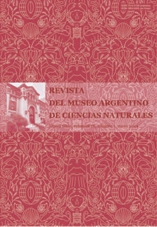Las abejas colectoras de aceite del género Paratetrapedia (Hymenoptera, Apidae, Tapinotaspidini) en la Argentina
Resumen
Se presenta una sinopsis del género Paratetrapedia Moure en la Argentina. Seis especies de Paratetrapedia son registradas para Argentina: P. fervida (Smith), P. leucostoma (Cockerell), P. nigrispinis (Vachal), P. punctata (Aguiar & Melo), P. pygmaea (Schrottky), and P. volatilis (Smith), de las cuales P. leucostoma, P. punctata y P. pygmaea son nuevos registros para el país. Se presenta una clave ilustrada para las especies, nuevos registros geográficos y notas sobre huéspedes florales.
Palabras clave
Texto completo:
PDFReferencias
Aguiar, A.J.C. 2009. Taxonomic revision of the bee genus Lophopedia Michener and Moure (Hymenoptera, Apidae, Tapinotaspidini). Zootaxa 2193: 1–52.
Aguiar, A.J.C. 2012. Tapinotaspidini Roig-Alsina & Michener, 1993. En: Moure, J.S., D. Urban & G.A.R. Melo (Orgs). Catalogue of Bees (Hymenoptera, Apoidea) in the Neotropical Region - online version. Available at http://www.moure.cria.org.br/catalogue. Acceso 05/01/2017
Aguiar, A.J.C. & G.A.R. Melo. 2005. Notes on the type species of the subgenera Paratetrapedia (Lophopedia) and P. (Amphipedia) (Hymenoptera, Apidae, Tapinotaspidini). Zootaxa, 1084: 31-42.
Aguiar, A. J., & Melo, G. A. (2007). Taxonomic revision, phylogenetic analysis, and biogeography of the bee genus Tropidopedia (Hymenoptera, Apidae, Tapinotaspidini). Zoological Journal of the Linnean Society 151:511-554.
Aguiar, A.J.C. & G.A.R. Melo. 2011. Revision and phylogeny of the bee genus Paratetrapedia Moure, with description of a new genus from the Andean Cordillera (Hymenoptera, Apidae, Tapinotaspidini). Zoological Journal of the Linnean Society 162: 351-442.
Cocucci, A.A., A.Sérsic & A. Roig Alsina. 2000. Oil-collecting structures in Tapinotaspidini: their diversity, function and probable origin. Mitteilungen Muenchener Entomologischen Gesellschaft 90: 51–74.
Gomiz, N.E., J.P. Torretta & S.S. Aliscioni. 2014. Zygostates alleniana (Orchidaceae: Epidendroideae: Cymbidieae: Oncidiinae): estructura floral relacionada a la polinización. Anales del Jardín Botánico de Madrid 71: e002.
Gomiz, N.E., J.P. Torretta & S.S. Aliscioni. 2017. New evidence of floral elaiophores and characterization of the oil flowers in the subtribe Oncidiinae (Orchidaceae). Plant Systematics and Evolution 303: 433–449.
Martins, A.C., A.J.C. Aguiar & I. Alves-dos-Santos. 2013. Interaction between oil-collecting bees and seven species of Plantaginaceae. Flora 208: 401-411.
Michener, C.D. 2007. The bees of the World, second edition. Baltimore: Johns Hopkins University Press.
Michener, C.D., J.C. Moure. 1957. A study of the classification of the more primitive non-parasitic anthophorine bees (Hymenoptera, Apoidea). Bulletin of the American Museum of Natural History 112: 395-452.
Mickeliunas, L., E. Pansarin & M. Sazima. 2006. Biologia floral, melitofilia e influência de besouros Curculionidae no sucesso reprodutivo de Grobya amherstiae Lindl. (Orchidaceae: Cyrtopodiinae). Revista Brasileira de Botânica 29: 251–258.
Moure, J.S. 1941. Notas sobre abelhas do grupo Tetrapedia Klug (Hym. Apoidea). Revista de Entomologia, Rio de Janeiro 12: 515–521.
Moure, J.S. 1948. Notas sobre algumas abelhas de Tacanas, Tucumán, Argentina (Hymenopt. Apoidea). Revista de Entomologia 19: 313–346.
Neff, J.L. & Simpson, B.B. 1981. Oil-collecting structures in Anthophoridae (Hymenoptera): morphology, function, and use in systematics. Journal of the Kansas Entomological Society 54: 95–123.
Roig-Alsina, A. 1997. A generic study of the bees of the tribe Tapinotaspidini, with notes on the evolution of their oil-collecting structures (Hymenoptera, Apidae). Mitteilungen Muenchener Entomologischen Gesellschaft 87: 3–21.
Vogel, S. 1974. Ölblumen und ölsammelnde Bienen. Tropische und Subtropische Pflanzenwelt 7: 285–547.
Enlaces refback
- No hay ningún enlace refback.

This work is licensed under a Creative Commons Attribution 3.0 License.

